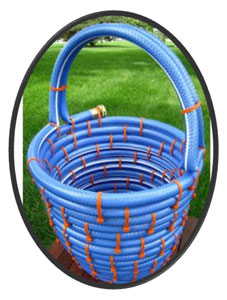
By Jean Ponzi
Reunion with a force from my young womanhood, Yoga, moved me in ways I was thrilled to find my body (at 3.5-score years of service) is still willing and able to go. Plus a few moves not so fondly recalled.
Connection catalyst, my longtime friend Sharon, celebrated her 80th birthday (!!) leading her Saturday Yoga class, the first time I came. Contemporaries filled the room’s circle of mats. Sharon teaches with gentle purpose, equally respecting flex and ability, conveyed in tones just strong enough so I could stretch and focus without straining to hear.
I enjoy joining Sharon’s class when weekend commitments permit, unless this dear ole’ body votes for rest – or other modes of intentional movement.
So it was that the first summer Saturday of real St. Louis heat, instead of cruising to a class, I joined my husband Dale in a practice at home, hauling out our hoses.
Hose Yoga is a practice for sure: focus, positioning, intention, limits, and strategic use of ball-valve shutoffs.
Ours is kind of a big place, where we’ve grown an urban forest. Spring rains were, thankfully, strong this year, yet we must prepare for heat-wave care for our arboreal kin, in ways that will not strain the very real limits of aging person-power.
Y-connectors and shutoffs let us limit and direct our sprinklers’ flow, sending water where it’s needed without waste. Like my pink foam yoga bricks, these gizmos support fluid movement, stretching hose across the yard to Just Be There.
Hose Yoga for one morning gracefully de-posed mid-summer hauling demands, which are 100% guaranteed to move hot persons to blow off watering practice.
Our intention supports the trees and bushes who, in turn, so kindly sustain and shade all the kinds of lives who share our place. As we’re linking hose to hose, I feel the body-mind-spirit alignment of a Sun Salutation centered in the gift of deep shade.
Like us, hoses evolve. Back in the 1600s, baronet Sir Richard Newdigate bested the bucket with a system crafted from leather he sewed into tubes reinforced by iron rings. His “watering pot” invention moved Europeans toward the irrigation we know. European “discovery” in the 1800s of rubber (well known to tropical folks) shifted hose culture to more flexible and durable alternatives. American chemist Charles Goodyear’s “Vulcanization” and industrial mass production secured essential status for the humble garden hose.
How did indigenous cultures hose? Mayan and Incan people worked with gravity – It’s the Law! – to terrace their arable land in accord with natural water flows. People of this continent’s Southwest fed themselves abundantly from Three Sisters gardens, tapping plants’ own relationships in wise, grateful use of the most limited seasonal rain. I’d bet the history of Yoga’s native places includes practices like these, with or without benefit of hoses.
What can we “modern” humans learn from ancient ways of being, seeing, moving and serving purpose? With five-buck parts and a screwdriver Dale replaced two hose-end connectors to keep two good ole’ hoses in good use. Waste not, water well!
For another one with leaks we couldn’t fix, I found DIY instructions to craft a nifty basket from a corpse hose. Will I embrace this practice too? From decades of knowing Me in the flow of All, frankly, I’m not holding my breath.
Jean Ponzi practices sharing Green perspective, through her work for the EarthWays Center of Missouri Botanical Garden and enviro-conversations on her Earthworms podcast, from KDHX.org.


